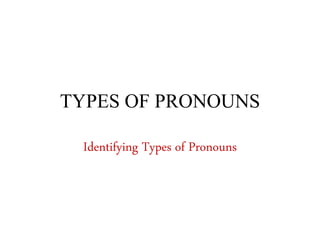
Types of pronouns
- 1. TYPES OF PRONOUNS Identifying Types of Pronouns
- 2. Types of Pronouns • Subject Pronoun • Object Pronoun • Possesive Pronoun To identifying types of pronouns.........
- 3. 1. Subject Pronoun The Subject of a sentence is.......... “A person or thing that performs the action of the verb” Subject Pronoun are used to replace the subject (person or thing) of a verb.
- 4. We do NOT normally say: “John is tall and John is intelligent.” So we would say: “John is tall and he is intelligent.”
- 5. What are the subject pronouns in English? These are the subject pronouns we use in English.....
- 6. When do you use IT? IT is normally used when we refer to objects, things, animals or ideas 1. It is also hairy. (It = the dog) 2. My bed is small but it is comfortable. (It = my bed) Sometimes when we don't know the sex of a baby (we don't know if it is a boy or girl), then we can use IT. “Their baby is very small. It only weights 2 kilos.” (It = the baby.)
- 7. When do you use IT? We use IT we when talk about the time, weather or temperature. 1. It is five o'clock (= the time is five o'clock) 2. It is cold today. (= the weather is cold today.) 3. It is 30º outside right now. (= the temperature is 30º outside right now)
- 8. 2. Object Pronoun Subjects are what the sentence is about. Objects are what is affected by the action of the subject. • I like whisky. (I is the subject). • I read books. (Books is the object as it is receiving the action).
- 10. Object pronouns are used instead of nouns, usually because we already know what the object is. It makes the sentence easier to read and understand and avoids repetition. We normally use object pronouns after a verb or a preposition.
- 12. The Object Pronoun – it • Be careful when using 'it' as an object pronoun because it is only in the correct context that it has meaning. It needs to have already been mentioned or obvious to the listener what you are referring to. Compare; • You are sitting on it! (The listener probably doesn't know what the speaker refers to). • The letter is on the sofa. You are sitting on it! (It is obvious in the second sentence that the reference is to the letter)
- 13. 3. Possesive Pronoun We use possessive pronouns to refer to a... specific person/people or thing/things (the "antecedent") belonging to a person/people (and sometimes belonging to an animal/animals or thing/things).
- 14. We use possessive pronouns depending on: • number: singular (eg: mine) or plural (eg: ours) • person: 1st person (eg: mine), 2nd person (eg: yours) or 3rd person (eg: his) • gender: male (his), female (hers) Possessive pronoun can: • be subject or object • refer to a singular or plural antecedent
- 16. • Look at these pictures. Mine is the big one. Examples........... (subject = My picture) • I like your flowers. Do you like mine? (object = my flowers) • I looked everywhere for your key. I found John's key but I couldn't find yours. (object = your key) • My flowers are dying. Yours are lovely. (subject = Your flowers) • All the essays were good but his was the best. (subject = his essay) • John found his passport but Mary couldn't find hers. (object = her passport) • John found his clothes but Mary couldn't find hers. (object = her clothes)
- 17. • Here is your car. Ours is over there, where we left it. (subject = Our car) • Your photos are good. Ours are terrible. (subject = Our photos) • Each couple's books are colour-coded. Yours are red. (subject = Your books) • I don't like this family's garden but I like yours. (object = your garden) • These aren't John and Mary's children. Theirs have black hair. (subject = Their children) • John and Mary don't like your car. Do you like theirs? (object = their car)
- 18. whose can also be a possessive pronoun. Look at these examples: 1. There was $100 on the table and Tara wondered whose it was. 2. This car hasn't moved for two months. Whose is it?
- 19. Reference • https://www.englishclub.com/grammar/pronouns-possessive.htm • http://www.grammar.cl/Notes/Object_Pronouns.htm • http://www.grammar.cl/english/subject-pronouns.htm • http://eslbee.com/sentences.htm • http://www.towson.edu/ows/sentences.htm
